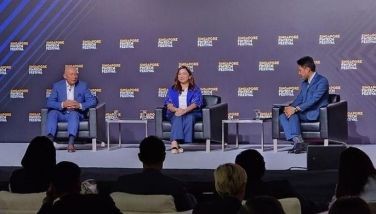Location-based services getting big among users of smartphones
MANILA, Philippines – Think about it this way: if you can find your way in the urban jungle using a digital map, tell your friends in your social network where you exactly are, share your location and earn a few badges for doing so, and create a digital footprint for your nomadic, tech-centered life, that in essence is geolocation, a capability built in most smartphones today around which sprung a full suite of location-based services that is the current rage in our digital towns.
Not that you really need a map to go anywhere, but using navigational digital aids like Google Maps, Google Places and Foursquare can make the daily urban merry-go-round a little bit easier and a little more fun. The classic “Have map, will travel” still holds true, except that paper maps are going the way of many analog products — fast becoming a thing of the past.
Tools of the trade
Google Map: Going to an unfamiliar place for the first time? No dice, just click on Google Map from your smartphone and it will give you a literal bird’s eye view of where you are going. It can also detect your location, give driving or walking directions to the place.
About month ago, Mashable reported that Google “has placed location and location-based search front-and-center in its search engine.” Needless to say, commerce is abuzz and business establishments were quick to hop on the Google Map train, which is a free service, with awesome marketing potential.
But give it to the Pinoy to find creative uses of this technology. After tropical storm “Ondoy” submerged Metro Manila last year, scientists and academicians developed a Flood Hazard Map using Google Maps and Flo2D, a flood routing application software, to construct a map that shows areas in the country that are prone to flooding.
Nabaha.com is a little hard to navigate though on a mobile device with a small screen and is still best for browser viewing, but when it starts raining really hard, at least you know you have an option to check if you are in a danger zone. And when push comes to shove you can always text: Hey, guys, I’m stuck somewhere between a river and an ocean, help! That is, if you can get a signal, or your battery won’t call it quits on you.
Google Places: Extending the functionality of the map, Google also introduced Places to help phone users find restaurants, coffee shops, bars, hotels, attractions, ATMs or gas stations wherever they are.
The Places app will be able to tell you that there’s a seafood restaurant 200 meters from your exact location, a fastfood 100 meters away, a coffee shop, ATM machine or a gas station not very far, or a botanical garden within another 500 meters.
Click one in the list and it will show the establishment in the map, plus instruction on how to go there, even giving you the phone number of the restaurant or gas station. More often than not, reviews will be available about the place by people who have been there or are frequent patrons. You will most likely find a share button within the app so you can send the address to any of your contacts.
Location services, however, are bi-directional. You can find places or people but you can also be found. That is, if you chose to be found, fully aware of the privacy implications.
Foursquare: The name of the game now is check-in. Location-based social networking website Foursquare allows you to “check in” at a coffee shop, for example, and earn a badge for frequenting the place. You can even be crowned “mayor” of the place if within 60 days you registered the most number of check-ins in a place. Some establishments give reward points or other incentives to their “mayors” and frequent visitors.
Though not nearly as ubiquitous now as Facebook and Twitter, the Foursquare mobile application has a very distinct appeal. But who cares if you had coffee in Makati, lunch at Bonifacio High Street, attended a meeting in Cubao, had another meeting at Eastwood, and capped the day at a bar in Libis? Your intimate group in your Foursquare friends’ list — most probably your family or your closest friends — cares. Who knows, your boss may even be happy about it as it tracks your daily movement.
This is assuming, of course, that your smartphone can download the application, can connect to Wi-Fi or you are subscribed to a data plan that gives you connectivity and access all the time.
Unlike the most popular social networking sites, Foursquare has stamped its service as strictly mobile as they have yet to allow checking in via the website or through a browser.
What’s in the horizon?
Facebook Deals: Facebook has also its version of feature though not yet available to smartphone users locally — the regional gap at work again here. With the Facebook Places feature still to be launched in the “near” future in this area of the world, Facebook has already launched Deals also in the United States.
“Everyone likes getting a good deal, but it’s not always easy to find the right one at the moment you could use one,” Facebook said in its blog. “Imagine that while you’re looking for a new place to try for lunch, you could see offers from restaurants nearby on your phone. On the other hand, I already love Zachary’s Pizza, so imagine if I were rewarded for coming back there every week with my friends.”
Recommendation engines have been around for some time, earning their first spurs in the movie and music industries. It works on the principle that if you listened to, watched or downloaded a song or movie, chances are you might be interested in similar music or movies.
Now with Deals, Facebook is betting that people would be interested in deals being offered around places they frequent. It could be an “eat-all-you-can” promo, a 50 percent discount on your favorite coffee blend, an offer to try a new pizza flavor or anything that could get you to the establishment.
Google Hotpot: The hottest spots in the city are coming to Google. With Hotpot, users will be able to rate places and recommend them to friends right from their Google profiles. These ratings will be sent as personalized messages for other Googlers in the vicinity.
Gowalla: Foursquare’s competitor is also making a beeline for a bigger share of the location-based services market in most parts of the world, although it remains to be seen if it will gain mass adoption. In social networking, it’s always the mass that matters. From a user perspective, the application may be the best so far in the genre but if your friends are not there, there’s no point.
Gowalla, however, is worth looking into, especially as Disney theme parks and resorts recently teamed up with Gowalla to enhance the visitor experience at the parks. Disney visitors can “check in” at the different attractions to earn digital stamps or earn Disney pins that can serve as memento to these places.
A study made by the Pew Research Center, however, showed that only four percent of American adults use location-based services, and in other parts of the world maybe a lot lesser. Many are predicting though that location-based services are going to be the next big thing in the mobile space because of their huge marketing and advertising potential.
- Latest





























